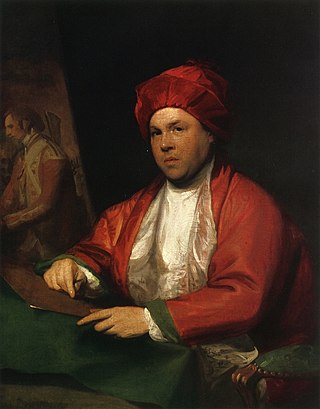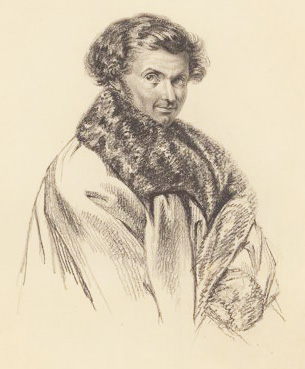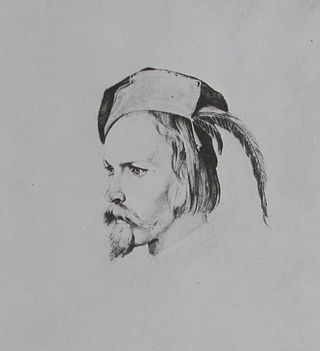
William Woollett was an English engraver operating in the 18th century.

William Augustus Guy was a British physician and medical statistician.

Girolamo Alibrandi (1470-1524), was an Italian painter, born and active in Sicily, called the Raphael of Messina.
John Alefounder was a painter of portraits and miniatures, working in London and later in India.
Sébastien Barras (1653–1703) was a French painter and engraver.
John Browne,, was an English landscape engraver.
James Caldwall, (1739–1822) was an English draughtsman and engraver.

William Capon was an English artist.
William Cochran (1738–1785) was a Scottish painter.

Georg Christoph Eimmart the Younger, a German draughtsman and engraver, was born at Ratisbon. He was instructed by his father, Georg Christoph Eimart the Elder (1603-1658), who was also an engraver, a painter of portraits, landscapes, still-life, and historical subjects. He studied at the University of Jena from 1654 to 1658. Eimmart the Younger resided at Nuremberg, where he died in 1705. He engraved some plates for Sandrart's Academia, and some small etchings of ruins, buildings, and vases, ornamented with figures, which have considerable merit. He was also a mathematician and astronomer, and published in 1701 Iconographia nova contemplationum de Sole.

François Eisen, an engraver, as well as a painter of historical and genre subjects, was born at Brussels about 1685. When twenty years of age he went to Valenciennes, and remained there, painting many pictures for its churches and monastic institutions, until 1745, in which year he removed to Paris. At the age of ninety he, with his wife, was admitted into the Hospital for Incurables, where he was still living in 1778. There are two of his works in the Museum of Valenciennes, a Vision of St. Mary Magdalen, and an Astrologer. He etched a plate from the picture by Rubens of Christ giving the Keys to St. Peter, which was in the church of St. Gudule at Brussels.

Johann Christian Michel Ezdorf or Etzdorf (1801–1851), a German landscape painter, was born at Pösneck, in the duchy of Saxe-Meiningen. He studied landscape painting in Munich and its environs, and displayed an especial talent in representing gloomy forests, taking as his models the works of Ruisdael and Van Everdingen. He visited Norway, the North Cape, Sweden, Iceland, and England. One of his best paintings is in the Modern Gallery at Munich; it represents a Forge by the side of a Waterfall. He died at Munich in 1851.
Roeland van Eynden was a Dutch painter. He was born at Nymegen in 1747, and died at Dordrecht in 1819. Like his brother he devoted but a portion of his time to painting, and is principally known by his works on art and artists, of which the most important is the Geschiedenis der Vaderlandsche Schilderkunst, written in conjunction with Van der Willigen, and published in 1816–1842.

Jacques-Philippe Ferrand (1653–1732) was a French miniaturist and painter in enamel.
Augustine Bryan was an English classical scholar, known for his edition of Plutarch's Lives.

Daniel Fohr, born at Heidelberg in 1801, first studied science, which he afterwards abandoned for the art of painting. After studying some time by himself, he went to Munich in 1829, and then to the Tyrol. He was court painter to the Grand-Duke of Baden, and died at Baden-Baden in 1862. There are by him in the Gallery at Carlsruhe:
Jacob Folkema, a Dutch designer and engraver, was born and died at Dokkum, in Friesland. He was first instructed by his father, Johann Jakob Folkema, a goldsmith, and studied afterwards under B. Picart at Amsterdam. During that time he worked for Royaumont's Bible, 1712, and Ruysch's Anatomy, 1737. Folkema was also an excellent engraver in mezzotint. He had a sister, Anna Folkema, who painted miniatures, assisted her brother, and engraved some few plates. She was born in 1695, and died in 1768. By Jakob Folkema there are, among others, the following plates:
Charles Fox (1794–1849) was an English engraver.

Jan George Freezen or Johann Georg Freesen, a portrait painter, was born in Palts, near Heidelberg, in 1701. He first studied under Jan van Nikkelen, and afterwards under Philip van Dyk, with whom he became one of the best scholars, and with whom he stayed seven years at the Hague. He was patronized by the Duke of Hesse, and was appointed as the historical and portrait painter at the court of Cassel. He possessed a great knowledge of paintings, which he acquired in Germany, Italy, France, and in the school of Philip van Dyk — an acquisition which was of the greatest use in the establishment of the Cassel Gallery. He died in Cassel in 1775.
Eliseus Bomelius was a German physician and astrologer.











